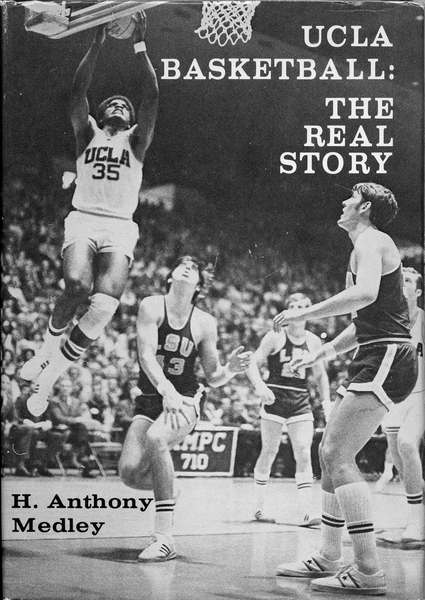|
Out of print for more than 30 years, now available for the first time as an eBook, this is the controversial story of John Wooden's first 25 years and first 8 NCAA Championships as UCLA Head Basketball Coach. This is the only book that gives a true picture of the character of John Wooden and the influence of his assistant, Jerry Norman, whose contributions Wooden ignored and tried to bury. Compiled with more than 40 hours of interviews with Coach Wooden, learn about the man behind the coach. The players tell their their stories in their own words. This is the book that UCLA Athletic Director J.D. Morgan tried to ban. Click the book to read the first chapter and for ordering information. |
|
The Tillman Story (4/10) by Tony Medley Run time 94 minutes. OK for children. A “documentary” is a film that dispassionately tells a factual story without a point of view. In fact, the dictionary definition of a documentary is “Presenting facts objectively without editorializing.” If it is a controversial subject, a documentary tells both sides and doesn’t take a position. Any film that tells a “factual” story with a point of view is not a documentary, it is propaganda, which is defined as “the systematic propagation of information reflecting the views and interests of those advocating such a doctrine or cause.” The Pat Tillman Story, lauded by almost all critics (Rottentomatoes has it with an 86% positive rating with 30 "fresh" valuations vs. 6 "rotten," including mine), is propaganda, pure and simple. Tillman was an NFL defensive back who enlisted to fight in Afghanistan. He was killed by friendly fire. The Army did not disclose the facts of his death until forced to. The family seized upon this and fought a battle about it. It’s unclear what they were fighting about, except that they claim they were misled about the facts of his death, which was originally reported as Killed in Action. Because he was killed by friendly fire the Tillmans have made a federal case out of it. This film presents the Tillman’s side of the story without one person explaining the other side. So let me set something straight here. Even in World War II, the armed forces, when reporting the death of a serviceman, did not reveal if the serviceman died from friendly fire, which many did in World War II. What are they going to do, write a letter and say, “We regret to inform you that your son was killed by mistake by his comrades. So sorry.”? No, that’s not the way to treat a tragic mistake. When people were killed by friendly fire in World War II their deaths were reported to their next of kin that they died in action, period. That is just common sense and respect for the bereaved. This film never explains this. It makes it look as if Tillman’s death was treated differently from all the other servicemen who have been killed in action by friendly fire. Not so! Never in this documentary is it explained in detail what happened from the shooters’ POV, although it is pretty evident that what they did was understandable. There was an explosion. Tillman was accompanying an Afghani, dressed like an Afghani, into the hills to explore. Another part of his squad saw the Afghani, thought he was the enemy, and shot him. Tillman and another member of his squad were high in the hills. The other guy kept down behind rocks so he couldn’t be shot. Tillman exposed himself, apparently yelling, “I’m Pat f---ing Tillman!” Obviously unable to hear or identify him, thinking he was the enemy, Bang! They shot him. That raises several questions in my mind. The first is, if people are shooting at you, why not protect yourself by hiding behind rocks, like the soldier accompanying Tillman did? That guy wasn’t killed. What kind of person stands up in front of people hundreds of yards away with high powered guns shooting at him and yells who he is, even if he does know they are his comrades? The movie is silent on this point, never raising the issue. The second is, don’t they have walkie-talkies, or similar, so they can communicate with one another? In this day and age? Why wouldn’t he get behind a rock to protect himself and try to contact them by electronic communication to tell them they were friends? The film doesn’t raise this issue. Clearly his buddies wouldn’t have killed him if they had known the identity of the person at whom they were shooting. So isn’t it possible that Tillman’s death was partly his fault, maybe more than his buddies? The third is, what are the positions of the people who shot him? They aren’t identified, aren’t interviewed, and are basically ignored. Fourth, where are the people from the Army or the DOD who might have a different point of view? They aren’t in this film. Regardless, if this weren’t propaganda but a real documentary, these are issues that would be covered in a documentary on Tillman’s death. But this film ignores all these questions. All it does is further the Tillman Family’s vendetta against the Army and Dept. of Defense with a 100% biased film. I’m not taking any position on who is responsible, whether the Army covered up, whether a medal was given for political purposes, or any of the other issues involved here. What I’m criticizing is a biased piece of propaganda that adds nothing to the public discourse. Had the filmmakers covered all the issues and not taken sides, they would have served a useful purpose. What they produced is basically worthless when it comes to finding out what happened and why, and that’s a shame.
|
|
|
